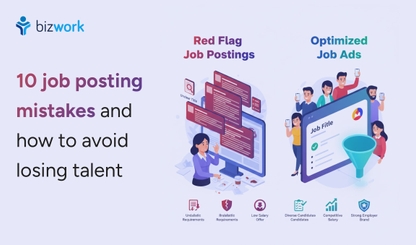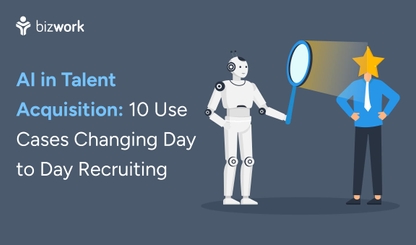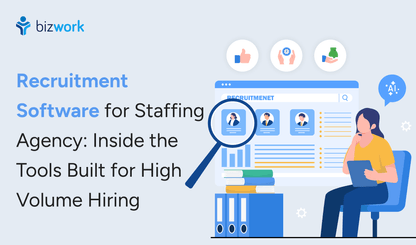You want to hire the right person? Well, that starts with the right job description. Why? It gives candidates their first impression of your team, your culture, and defines the role’s demands. A job description may seem simple, but to juggle multiple roles, define company culture, and make each post stand might take hours.
The post still feels lifeless. Candidates scroll past, the system filters half of them out, and the people you actually want never apply. What happens then? Of course, another week slips by, which keeps the role still open. This puts quite a pressure on your team.
For recruiters and small business owners, this could be costly. Every unclear or uninspiring posting risks missing the people your company needs to grow. The challenge here is to write clearly and authentically, which shows responsibilities, culture, and opportunity in a way that connects to your candidates.
Instead of listing duties and requirements, AI for Job Descriptions creates posts that speak clearly, connect with candidates, and show what your company is like. First lets understand what is an AI job desc generator?
What is an AI Job Description Generator?
An AI job description generator is like a writing partner that helps you put your thoughts into words. You don’t need to face a blank page anymore, just add the key details:
- Role title
- Key responsibilities
- Qualifications
The tool then produces a structured, professional job description.
Templates can make job postings feel repetitive and flat, missing the personality of your company. With AI recruitment software, a job description generator takes the details you provide and turns them into descriptions that feel natural, reflect your brand, and match today’s hiring standards.
Well, how about we take a look at how these tools work in practice?
How AI Helps you Write Job Descriptions
AI job description tools are built on advanced language models like ChatGPT, Gemini, or Claude. These tools understand context and patterns in language, and help you with your job posts by making it smooth and natural, almost as if an experienced recruiter had written them by hand.
If you provide few points about a marketing manager role, the tool can turn them into clear, natural sentences:
“Our company is looking for a marketing professional with experience running campaigns and delivering measurable results.” It communicates expectations clearly without sounding stiff or robotic.
Remember, LLMs are there to speed up your writing, not take over. You still decide the tone, the details, and how the role comes across.
Having seen how AI works, let’s compare it with the template-based approach many companies still use.
Templates vs AI-Generated Writing
When it's about writing job descriptions, many companies start with templates. They are quick and easy but they might produce generic postings that fail to capture your team’s unique qualities.
AI-generated content offers a different approach, creating descriptions that read naturally, highlight key responsibilities, and reflect your company’s voice. Comparing the two helps show where AI can add value.
| Aspect | Templates | AI-Generated Content |
|---|---|---|
| Structure | Provides a basic framework to ensure you cover standard sections | Adapts to your input, creating natural flow and readable content |
| Originality | Can feel repetitive and predictable across multiple postings | Highlights what makes a role or team unique |
| Culture & Tone | Rarely reflects company culture or voice | Captures tone and culture naturally |
| Language | Standard phrasing, may feel generic | Uses inclusive, unbiased language without extra effort |
| Readability | Human-friendly but may miss ATS optimisation | Optimised for both humans and applicant tracking systems |
For example, instead of a generic line like, “Candidate must have 5 years’ experience,” an AI-generated description could say,
“Our company is seeking someone who has built marketing campaigns from the ground up and can show measurable results over the last 5 years.” That one line communicates capability and expectations clearly, without sounding cold.
Understanding these differences makes it clear why AI-powered descriptions are increasingly valuable for modern recruitment.

Benefits of AI-Powered Job Descriptions
Using AI for job descriptions creates postings that are clear, consistent, and engaging, helping attract the right candidates and improve the hiring process.
- Time efficiency: What used to take hours can be completed in minutes, freeing recruiters to focus on interviews and engagement.
- Consistency: Across multiple roles, your company voice remains intact.
- Use Clear and Inclusive Language: Biases in phrasing can be caught and corrected automatically.
- ATS-friendly formatting: Keywords and structure are optimised for applicant tracking systems, reducing the chances of good candidates slipping through the cracks.
- Improved candidate experience: Clear and readable postings improve application quality and reduce confusion.
- Scalability: Easily create multiple postings for similar roles without losing uniqueness.
Small businesses can use recruiting software for small business or remote hiring software to manage several open roles without needing extra HR staff.
With benefits in mind, let’s look at the key features to look for in an AI tool.
Important Features in AI Job Description Tools
Not all tools are created equal. When evaluating an AI job description generator, focus on:
- Human-like language generation: Avoid outputs that sound mechanical or repetitive.
- Customisable templates: Adapt tone, format, and style to your company’s voice.
- Bias detection: Promote inclusivity in phrasing and requirements.
- ATS compatibility: Optimise for keywords and readability to improve candidate flow.
- Job posting personalisation: Customise descriptions for role type, team, or location.
- Seamless integration: Integration with AI recruitment software or other HR tools for a smooth workflow.
Knowing these features helps you use AI effectively when writing your next job description. Though you should also know the better tactics to write job descriptions with AI.
How to Write a Job Description with AI
Even the best AI tool needs clear inputs. Here’s a framework:
- Define the role clearly: Include the title, department, and main responsibilities.
- Outline required skills and qualifications: Think about must-have versus nice-to-have skills.
- Highlight perks and benefits: Include salary range, flexible hours, remote options, or professional growth opportunities.
- Use an AI generator: Feed in the details and let it produce a draft.
- Review and refine: Ensure the tone aligns with your company, adjust phrasing, and check for inclusivity.
- Publish and track: Monitor engagement and candidate response; adjust as needed.
Based on above learning, an exemplar prompt can be- Create a professional, inclusive, and engaging job description for the role of [Role Title] in the [Department/Team]. The candidate will be responsible for [Main Responsibilities].
Must-have skills: [List must-have skills] Nice-to-have skills: [List nice-to-have skills]
Perks & benefits: [Salary range, remote/flexible hours, growth opportunities, other perks]
The tone should be human-friendly, clear, and attractive to top talent. Highlight the company culture, opportunities for growth, and make the description concise and easy to read. Avoid jargon and ensure inclusivity.
Suggest a title and opening paragraph that grabs attention and encourages applications.
Following these steps creates a workflow that saves time while producing postings that attract high-quality candidates.
Let’s explore some tips to make these postings even more effective.
Top 6 Tips for Writing Best AI-Powered Job Descriptions
To get the best results:
- Keep sentences concise and easy to read.
- Highlight what makes your company and team special.
- Use keywords naturally for ATS optimisation.
- Stick to recognised job titles to improve searchability.
- Test multiple drafts to see which resonates best with candidates.
- Include a clear call to action, such as “Join our team and help shape our next chapter.”
Even when using AI, human oversight ensures authenticity, accuracy, and engagement. Now, let’s review some of the tools for AI job description generation available in 2025.
Top 5 AI Tools for Writing Job Descriptions
Several AI tools can help create job descriptions that are clear, engaging, and aligned with your company’s voice. These tools help to save time, suggest better phrasing, and make it easier to produce postings that attract the right candidates.
Choosing the right AI tool for job description depends on your needs, team size, and hiring goals.
- ChatGPT: Best for flexible and easily customisable prompting.
- Gemini: Best when you need nuanced phrasing suggestions for role-specific needs.
- Claude AI: Better for focused usage where readability and inclusive language are prime.
- Textio: Highlights engagement, tone, and inclusion improvements.
- Recruitee AI: Best for those who need AI recruiting software integration for seamless workflows.
Each tool has its strengths. The choice depends on your company size, hiring volume, and workflow needs.
Understanding the tools is one thing, but how you use them matters just as much.
Best Practices and Challenges for AI Job Descriptions
AI can make job description writing faster and more consistent, but its true value comes from combining technology with human insight. Here’s a clear guide to practices that work and challenges to be aware of.
1. Use AI to Support Your Work
- Use AI to handle repetitive phrasing and structure, but always review the output.
- Ensure the language reflects your company culture and the expectations of the role.
- Human oversight helps preserve authenticity and prevents generic postings.
2. Keep Job Descriptions ATS-Friendly
- Maintain clean formatting so applicant tracking systems can easily scan postings.
- Include relevant keywords naturally to improve visibility without stuffing.
- Structure responsibilities, qualifications, and benefits for easy readability.
3. Show Your Company’s Personality
- Adjust AI-generated text to match your company’s tone and style.
- Highlight what makes your team, culture, and projects unique.
- Make descriptions engaging to attract candidates who fit your company’s ethos.
4. See What Works and Update Posts
- Track candidate responses to see which postings perform best.
- Test different AI-generated variations to improve clarity and appeal.
- Adjust phrasing or highlight perks differently if applications don’t align with expectations.
5. Work with Remote Hiring Tools
- Pair AI-generated descriptions with remote hiring software for distributed teams.
- Streamline posting, tracking, and managing applications across locations.
- Reduce administrative burden while maintaining consistent hiring standards.
6. Be Aware of Common Challenges
- Over-reliance on AI can lead to generic, uninspiring postings.
- Highly specialised roles may require human input to capture nuanced requirements.
- Compliance and privacy considerations must be followed when integrating AI with ATS systems.
- Balance is key: let AI handle repetitive tasks while humans ensure clarity, accuracy, and authenticity.
Future of Job Description Writing
Expect AI to become more sophisticated:
- Personalised postings tailored to candidate personas.
- Data-driven recommendations for qualifications, salary ranges, and benefits.
- Multilingual capabilities for global hiring initiatives.
- Predictive insights to identify which postings attract top candidates.
Early adopters will gain a competitive advantage, hiring smarter and faster without sacrificing quality or candidate experience.
Integrating AI into job description writing is about improving recruitment while keeping candidates engaged.
Using AI for Recruitment
Using AI for Job Descriptions alongside the best AI recruiting tools , helps with teams to create postings that are clear, approachable, and inclusive.
Small businesses, startups, and large companies alike can improve candidate experience and reduce repetitive work, freeing HR teams to focus on building relationships with candidates.
At the end of the day, the goal is simple: better descriptions, better hires.
Conclusion
Creating effective job descriptions is kind of a mix of art and science. AI for job descriptions makes the process fast and efficient, but human oversight ensures authenticity, clarity, and engagement.
Using AI with your own judgment helps create job postings that draw the right candidates, save time, and show your company’s brand. Writing a good job description is the first step toward better hiring.

FAQs
It’s a tool that helps you create structured, clear, and professional job postings. You provide key details about the role, and the tool generates well-written descriptions that reflect your company’s voice.
No. AI handles repetitive writing tasks and formatting, but human oversight is essential to ensure accuracy, reflect company culture, and capture nuanced requirements for specialised roles.
Yes. Most AI tools produce postings that work well with applicant tracking systems. You still need to include relevant keywords and structure content clearly to maximise visibility.
Absolutely. AI-generated descriptions can be paired with remote hiring software to manage distributed teams efficiently, keeping postings consistent and tracking applications across locations.
The best tools depend on your team size, hiring goals, and workflow. Top options offer easy integration with ATS, natural-sounding outputs, and features like keyword suggestions, formatting assistance, and remote hiring support. You can start with BizHire which combines all.



